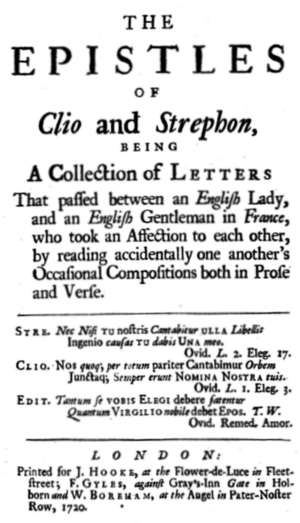Martha Fowke facts for kids
Martha Fowke, later known as Martha Sansom, was an English poet who lived from 1689 to 1736. She was part of a group of writers connected to Aaron Hill. Martha was born in Hertfordshire on May 1, 1689. Her family was Roman Catholic gentry. She was taught at home and at a boarding school. Her father, Major Thomas Fowke, supported her writing more than her mother, Mary. After her mother passed away in 1705, Martha moved to London. Around 1721, she married Arnold Sansom. Their marriage was not a happy one. In 1730, she moved with her husband to East Anglia.
Martha Fowke: A Poet's Journey
Martha Fowke's writings started to become well-known with her book Clio and Strephon in 1720. This book was first published without her name. It was so popular that it was printed many times until 1732. In her writings, Martha used the name "Clio" for herself. "Strephon" was the poet and journalist William Bond.
The book Clio and Strephon was a collection of letters. These letters were written as poems and stories. The first edition in 1720 had a long title: The Epistles of Clio and Strephon, being a collection of letters that passed between an English Lady, and an English Gentleman in France, who took an Affection to each other, by reading accidentally one another's Occasional Compositions both in Prose and Verse. The book was republished twice while Martha was alive. The third edition in 1732 included notes and comments by John Porter.
Martha's other poems appeared in different publications. These included Delights for the Ingenious (1711) and Anthony Hammond's New Miscellany (1720). Her work was also in Richard Savage's collection, Miscellaneous Poems and Translations (1726). Some of her poems were even published in the Barbados Gazette.
A Woman's Voice in Poetry
In her poems, Martha Fowke sometimes showed her feelings of frustration. She felt that society expected women to only stay at home. Martha did not want to be limited to just a home role. She was very serious about her writing. She believed that women and men should be equal partners in a marriage. She thought they should be equal in their minds and thoughts.
Friendships with Other Writers
Martha Fowke had important friendships within her group of writers. One of her closest friends was Aaron Hill. After her death, her letters to him were published. This book was called Clio: or, a secret history of the life and amours of the late celebrated Mrs. S-n---m. Written by herself, in a letter to Hillarius.
Another friend was the poet and painter John Dyer. He painted a picture of Martha. He also wrote two poems about her from Wales. These poems, along with Martha's replies, were published in Richard Savage's collection in 1726.
Martha was seen as an equal by her fellow writers. However, a former friend, Eliza Haywood, wrote a negative account about Martha's relationships. This writing affected Martha's reputation. Martha's own autobiographical work, Clio, was published in 1752. It had a note from 1723, suggesting it was shared as a handwritten copy before it was printed.


